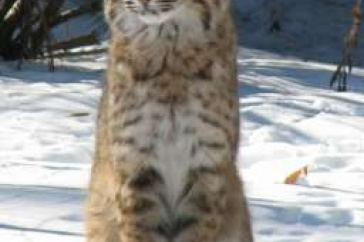UNH Research: New Hampshire's Bobcats Are Thriving

A bobcat in a Jaffrey backyard. Credit: Juliet Bell
New Hampshire's bobcats are on the rise -- and on the move, showing up in places they've never been reported before. Those are the major findings from a four-year study of the animal that puts the "wild" into wildcat, conducted by scientists from the University of New Hampshire and N.H. Fish and Game.
Bobcats, whose habitat historically has been the rocky outcroppings and rugged geography of southwestern New Hampshire, now exist throughout the Granite State. Lead researcher John Litvaitis, professor of natural resources and the environment at UNH, and colleagues were particularly surprised at the abundance of bobcats in southeastern New Hampshire, an area which for decades had "zero bobcats," he says.
The researchers estimate that New Hampshire is now home to 800 - 1,200 bobcats, up from 100 - 150 in mid-1980s. Several factors likely contributed to their rebound: Closing the hunting season for the cats in 1989 certainly had an impact, and Litvaitis wonders if the proliferation in wild turkeys, on which bobcats prey, is playing a role in their abundance.
The study, which has yielded several articles that will appear in peer-reviewed journals, indicates that the famously elusive feline has adapted to live among us. Bobcats were even observed stalking birdfeeders to prey on unsuspecting squirrels that frequented them.
"I thought I knew this animal really well," says Litvaitis, who has studied bobcats since the 1980s. "The idea that this animal does not do well with humans is being contradicted."
Launched in November 2009, the UNH study trapped 19 bobcats in two areas: the southwestern corner of the state around Keene and a southeastern swath from Barrington to Gilford. These collared cats were sources of rich data; radio collars tracked their movement via GPS and small tissue samples allow for further DNA analysis.
A second, less direct data collection method relied on citizen-scientists around the state, who sent photographs and descriptions of bobcat sightings in to the project's website. In addition to incidental sightings, the project recruited 100 volunteers to deploy motion-sensitive wildlife cameras. Bobcat sightings were so robust that the researchers discontinued this effort after receiving more than 1,000 observations.
"Within the first two weeks of our first announcement of this project, we got 200 phone calls," says Litvaitis. That's a dramatic increase from just a decade ago, when a bobcat sighting would be big news. From 1990 to 2004, only 90 bobcat sightings were reported statewide. "I could do that in three weeks now," he says.
Found throughout the continental United States, bobcats can weigh up to 35 pounds and sport a namesake stubby tail. The carnivorous predators have few natural enemies other than humans. They're not aggressive toward humans, but "they're not beyond taking advantage of chickens, small dogs and cats," says Litvaitis.
Bobcats' heyday was the early 20th century, as agricultural land ceded to early forestation. By the late 1980s, the bobcat population was so diminished that the nearly two-century hunting and trapping season for them was discontinued. Bobcats, along with the much rarer Canada lynx, comprise the generic category "wildcats".
Litvaitis says the increase of bobcats in New Hampshire has not diminished their popular appeal. "Everyone's gaga about bobcats," he says. "It's an animal that exemplifies the things we like about nature. If you've got bobcats, the world's still pretty good. We haven't screwed everything up."
In addition to Litvaitis, researchers include Patrick Tate '99, '07G and Mark Ellingwood from N.H. Fish and Game; UNH professor of natural resources and the environment Marian Litvaitis, who is conducting genetic analysis on New Hampshire's bobcat population; UNH master's students Tyler Mahad and Rory Carroll; and alumni Derek Broman '12G, now with the Texas Parks and Wildlife Division, and Greg Reed '13G, now with Oregon Department of Fish and Wildlife.
Funding for the study was provided in part by the Federal Aid in Wildlife Restoration Act, McIntire-Stennis Program (USDA), and New Hampshire Agricultural Experiment Station.
The University of New Hampshire, founded in 1866, is a world-class public research university with the feel of a New England liberal arts college. A land, sea, and space-grant university, UNH is the state's flagship public institution, enrolling 12,300 undergraduate and 2,200 graduate students.
Photographs available to download:
/unhtoday/news/releases/2014/11/images/kittenstevenscat-3132.jpg
A kitten released from a coyote set in Lyndeborough.
Credit: Mark Stevens
/unhtoday/news/releases/2014/11/images/bobcatbell-3978.jpg
A bobcat in a Jaffrey backyard.
Credit: Juliet Bell
/unhtoday/news/releases/2014/11/images/litvaitis-02-7198.gif
University of New Hampshire bobcat researcher John Litvaitis, professor of natural resources and the environment.
Video: UNH bobcat research
http://www.youtube.com/watch?v=B0y9_ihBp8g
John Litvaitis is available at john.litvaitis@unh.edu or 603-862-2094. UNH Media Relations has an on-site ReadyCam broadcast studio available through VideoLink (617-340-4300) for television interviews and an ISDN line for radio interviews.
Latest News
-
October 30, 2024
-
October 10, 2024
-
October 8, 2024
-
October 3, 2024
-
October 1, 2024
















































